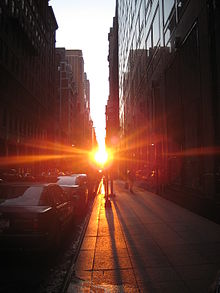Manhattanhenge
As Manhattanhenge one occurring twice a year phenomenon is called, in which the light of the setting sun in a straight line through the canyons of after the 1811 Commissioners' plan built east-west streets of Manhattan in New York City falls.
The name was coined by the American astrophysicist Neil deGrasse Tyson , who published an article about it in the journal Natural History in 2002 and is derived from Stonehenge , which is said to have been used to determine the day of the solstice , among other things . The New York Times also used the term Manhattan Solstice (German: Manhattan Solstice ) for the constellation, but this is misleading because it is not a solstice. The phenomenon occurs in late May and mid-July, around 3 weeks before or after the summer solstice.
In early December and early January, the light of the rising sun falls similarly through the street canyons.
Individual evidence
- ↑ When the red sun sinks into the tar in Manhattan
- ↑ The universe revolves around Manhattan in FAZ from July 19, 2013, page 35
